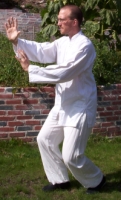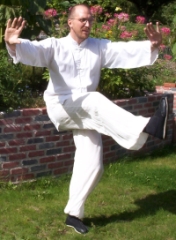 |
Taiji Quan (Tai Chi Chuan) is a classical Chinese martial art and health callisthenic. We practice Tai Ji with focus on health, well being, self defence and personal development. The movements are relaxed, natural, flowing, soft and strengthening for body and soul. You learn to use your intention instead of muscular strength, using 4 ounce of power to move 1000 ponds, using your opponents force against himself by leading his force into emptiness and much more.We practice Sun style Tai Ji in the traditional way with warm up qi gong, form sequence practice, single movement practice, applications of movements, and pair practice (pushing hands) and fighting exercises (san shou). A typical workout consist of warm-up qi gong, form practice and partner practice.
Per Nyfelt who is teaching Tai Ji at the Alipsa institute has studied Tai Ji for 28 years including 10 years under Sun Jian Yun who was the heir of the Sun style founder Sun Lu Tang. |
Tai Ji and health
There are plenty of anecdotes from people who have dramatically improved their health by practicing Tai Ji. In the middle of the 19th century a number of influential people in Beijing where cured from their health issues and became after that enthusiastic promoters in the popularization of Tai Ji – an important contributing factor to why Tai Ji is so popular in China and the rest of the world today. Scientific studies(1) have shown positive effects of practicing Tai Ji in balance improvement, flexibility, cardiovascular system, and in recovering from stroke, heart failure, high blood pressure, MS, Parkinsons, Alzheimers and fibromyalgia.
Tai Ji as martial art
Tai Ji is a martial art that works very differently than most other forms of martial arts. Instead of focusing on expression of power, emphasize is instead on ability to listen with the whole body, following the opponent and using the opponents force against himself. We study how to use softness to overcome hardness, adherence to overcome dominance, intelligence to overcome brutality etc. In order to be able to do this one must find a way to move that allows listening and adherence without loosing the ability to move freely or expressing power at any moment. We practice this by using the form as a tool to understand ourselves and the techniques of Tai Ji and also by practising pushing hands to understand others and the use of these techniques. After a couple of years of training we test our understanding when we practice sparring (san shou).
What happens when you have practised Tai Ji for a while?
Besides better health and ability to defend oneself when needed there are a number of other things that you develop after practicing Tai Ji for a while. Some of these thing that we have observed in ourselves and our students are increased self confidence, greater awareness and presence, agility and flexibility, and increased personal power and balance – both physically and mentally.
Distinguishing characteristics of Sun style Tai Ji Quan
- Coordinated advance and retreat.
This means that the body is coordinated in all movements. Coordination of movement is achieved when the back foot follows the front when advancing and the front foot follows the back foot when retreating. - Postures are comfortable, extended, round, flexible, soft and natural
- Empty and solid is clearly separated.
- Movements are like clouds in the sky and as flowing water i.e continuously without breaks
- At every turn of the body there is opening and closing
Important principles of practice.
The entire body should be relaxed, round, straight, agile and have a constant feeling of power. Pay attention on your body sensations and your mind when practising. View the form as an instrument that helps you investigate and understand things about yourself, Tai Ji Quan and the connection between the two. Focus on developing whole body power i.e. the whole body and mind is involved in each movement.
 |
Per Nyfelt who is teaching Tai Ji at the Sancai school of martial Arts has lived in China for many years and learned Tai Ji there. He was a disciple of the daughter of Sun Lu Tang, Sun Jian Yun from 1993 to the time of her passing in 2003. |